The Indian Army has stood for valour and honour for a very long time. It provides some of the best job possibilities and one of the largest militaries in the world for people who are prepared to serve their country. The Indian Army is in charge of securing the frontiers of the country. It requires substantial training and preparation due to its tremendous specialism. In this article, we are going to discuss about the Indian Army Ranks.
Indian Army Ranks and Insignia
The three broad types of Indian Army Ranks are Commissioned Officers, Junior Commissioned Officers, and Other Ranks.
In most cases, these ranks match those of the British Indian Army. There are still certain ranks with traditional names.
All the ranks of the Indian Army are enlisted in the tables below in descending order of control.
Indian Army Officer Ranks
| Rank | Insignia | Description |
|---|---|---|
| Field Marshall (Honorary/ Wartime rank) | 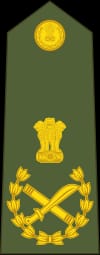 | National emblem over a crossed baton and sabre in a lotus blossom wreath. |
| General (Held by the Chief of the Army Staff and the Chief of the Defence Staff, both wearing a distinct insignia) | 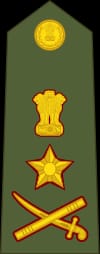 | National emblem over a five-pointed star, all over a crossed baton and sabre. |
| Lieutenant general (Held by paramilitary force commanders, corps commanders, major staff officers at army headquarters, and other extremely significant posts.) |  | National emblem over crossed baton and sabre. |
| Major general (The most junior general in the Indian Army, who commands divisions and holds other significant positions) |  | Five-pointed star over crossed baton and sabre. |
| Brigadier (Not considered as general in the Indian Army) |  | National emblem over three five-pointed stars in a triangular formation. |
| Colonel | 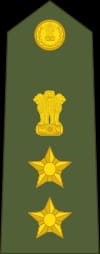 | National emblem over two five-pointed stars. |
| Lieutenant colonel |  | National emblem over five-pointed star. |
| Major |  | National emblem. |
| Captain | 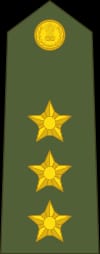 | Three five-pointed stars. |
| Lieutenant | 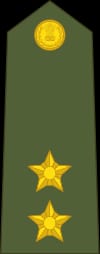 | Two five-pointed stars. |
| Officer cadet | (No insignia) | Shoulder tags with training academy name |
Indian Army Ranks and Insignia (Junior Commissioned Officers and Other Ranks)
| Ranks | Insignia | Description |
|---|---|---|
| Subedar Major | 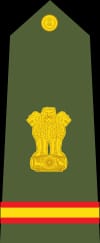 | Golden national emblem with stripe. |
| Subedar | 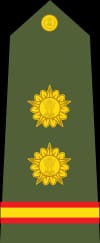 | Two golden stars with stripe. |
| Naib Subedar | 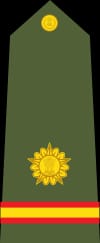 | One golden star with stripe. |
| Havildar |  | Three rank chevrons |
| Naik |  | Two rank chevrons |
| Lance Naik |  | Single rank chevron |
| Sepoy | (No insignia) | --- |
Indian Amy Rank List – Explained
Commissioned Officers
Army leaders known as commissioned officers might take charge of a Platoon, Company, Battalion, Brigade, Division, Corps, or the entire army.
All Indian Army officers are initially inducted as officer cadets at the time of enlistment. A uniform for an officer without any insignia serves as a sign of the rank of officer cadet.
Indian Army officers are regularly subjected to various courses and evaluated on merit for promotions and appointments throughout their careers. Significant promotions up to Lieutenant Colonel or equivalent are based on time spent, while those for Colonel and above are based on selection, with promotion to Colonel also based on time served (subject to clearance of Part B and Part D exam for Major and Lieutenant Colonel).
Due to steep hierarchy and few vacancies in the Indian Army ranks promotion, most of the officers retire at the rank of Colonel and only a few make it to the rank of Brigadier and above.
To join the Indian Army as a Commissioned Officer after completing the 12th grade, there are two primary pathways available: the National Defence Academy (NDA) and the Combined Defence Services (CDS) examination. Read more about How to Join Indian Army after 12th as Commissioned Officers?
Flag commissioned officers
Field Marshal – The highest possible rank in the Indian Army is Field Marshal (or field marshal, abbreviated as FM), a five-star general officer rank. Although it is not used in the regular army structure of the regular army, Field Marshal is the rank directly above General. With only two awards, it is mostly a ceremonial or military rank.
General – In the Indian Army, the rank of general is a four-star general officer. In the Indian Army, it is the highest active rank. The five-star position of field marshal, which is primarily a wartime or ceremonial post, is above the General rank the three-star rank of Lieutenant General is ranked below.
To distinguish them from the lower general officer ranks like Lieutenant General and Major General, a General may be referred to as a full general or four-star general. Admiral and Air Chief Marshal, are the corresponding ranks in the Indian Navy and Air Force respectively.
In the Indian Army, a Lieutenant General holds the three-star general officer rank. In the Indian Army, it is the second-highest active rank.
Lieutenant General – Lieutenant generals are ranked below the four-star rank of General, which is held by the Chief of the Army Staff, and above the two-star position of Major General.
Vice Admiral and Air Marshal, are the corresponding ranks in the Indian Navy and Air Force, respectively.
Lieutenant General-level officers hold crucial positions at army headquarters and in army commands.
Major General – In the Indian Army, a Major General is a two-star general officer. In the Indian Army, it is the third-highest active rank. Major generals are ranked between brigadier, with one star, and lieutenant general, with three stars.
Rear admiral and Air Vice Marshal are the comparable ranks of the Indian Navy and Air Force, respectively.
Brigadier – In the Indian Army, the rank of brigadier is one star. Colonel and Major General, both two-star ranks, are below the rank of brigadier.
Commodore and Air Commodore, are the corresponding ranks of the Indian Navy and Air Force, respectively.
Senior officers
Colonel – A rank in the Indian Army is Colonel. This rank is lower than a Brigadier and higher than a Lieutenant Colonel, the same as in other forces. In the Indian Navy and Indian Air Force, it is the equivalent of Captain and Group Captain, respectively.
In the Indian Army, colonels are responsible for leading battalion-sized formations (infantry battalions, artillery regiments, and armored regiments). Until the 1980s, lieutenant colonels oversaw battalions (and their equivalents).
Lieutenant Colonel – A battalion or regiment is essentially under the command of a lieutenant colonel. Lieutenant Colonel comes above Major and below Colonel in the rank hierarchy.
Major – Major is a military rank of commissioned officer status, and there are equivalent positions in many armed forces around the world. In some jurisdictions, major is known as commandant. Major is one rank below Lieutenant Colonel and one rank above Captain in the armed forces when used without a hyphen and without any extra indicators. It is regarded as the field officer rank with the least experience.
Junior officers
Captain – The highest rank a soldier can obtain while still serving in the field is Captain in the Indian Army. The command of a company of troops has historically corresponded to the army rank of captain, which is a commissioned officer rank. Some air and marine forces also use the title, however it often designates a senior officer. Currently, a company or artillery battery’s commander or second-in-command is normally a captain.
Lieutenant – Lieutenant is a junior officer position in the Indian Army. They are placed just below the Captain and above the Officer Cadets.
Officer Cadet- Military cadets who are in the process of learning how to become commissioned officers hold the rank of officer cadet.
Junior commissioned officers
The British Army’s warrant officers are roughly equivalent to Junior Commissioned Officers, who are promoted from Non-Commissioned officers. Senior non-commissioned officers are elevated to the JCO rank based on merit and seniority, subject to the availability of openings. The Junior Commissioned Officers are situated between the Commissioned Officer and the NCOs. As they have a minimum of 28 years of service and are known as Sahab by all ranks, they are treated with the utmost respect.
The three JCO grades are Subedar Major, Subedar, and Naib Subedar. JCOs are given supervisory responsibilities.
Junior commissioned officers are given special treatment and are given many more benefits.
Subedar Major – Subedar-major, historically known as the Viceroy’s commissioned officer in the British Indian Army, is the senior-most rank of a junior commissioned officer in the Indian and Pakistani Armies.
Subedar – In the Indian Army, a subedar is a junior commissioned officer; in the Pakistani Army, a subedar is a senior non-commissioned officer; and in the British Indian Army, a subedar was previously a viceroy’s commissioned officer.
Naib Subedar – The junior-most position among Junior Commissioned Officers is Naib Subedar. In place of lieutenants, JCOs with the rank of Naib Subedar frequently command platoons in an infantry company, with a major serving as the company commander and a captain as second-in-command.
Other Ranks in Indian Army
Non commissioned officer
Non-Commissioned Officers (“NCOs”) are troops who have been given leadership roles and are the equivalent of junior non-commissioned officers (sergeants and corporals) in Western forces.
Havildar – In the armed forces of India, Pakistan, and Nepal, the havildar rank is comparable to sergeant. In cavalry units, where daffadar is employed instead, it is not used.
A havildar sports three rank chevrons, similar to a British sergeant.
Naik – A corporal’s equivalent in the Indian Army, Pakistani Army, and Bangladeshi Police is a naik. Prior to its use as a synonym for corporal in British India, the Tamil word naik denoted a lord or governor.
The rank, which stood between lance naik and havildar, was formerly employed by the British Indian Army and the Camel Corps. The equivalent is lance daffadar in cavalry forces. Naiks dress with two rank chevrons, similar to British corporals.
Lance Naik – In the Indian and Pakistani armies, as well as the British Indian Army before to 1947, the rank of Lance Naik , which is below naik, is the equivalent of lance corporal. Acting lance daffadar is the equivalent in cavalry regiments. Each wears a single rank chevron like a lance corporal in the British army.
Sepoys(Soldiers) – Sepoys are the foot soldiers in the Indian Army who form the backbone of it.
Indian Army Ranks and Salary
If you want to join the Indian Army you should be aware of the salary range of the different ranks of the Indian Army.
| Ranks | Salary Range |
|---|---|
| General | ₹ 250000 |
| Lieutenant General | 182,200–224,100 |
| Major General | ₹ 144200 to ₹ 218200 |
| Brigadier | ₹ 139600 to ₹ 217600 |
| Colonel | ₹ 130600 to ₹ 215900 |
| Lieutenant Colonel | ₹ 121200 to ₹ 212400 |
| Major | ₹ 69400 to ₹ 207200 |
| Captain | ₹ 61300 to ₹ 193900 |
| Lieutenant | ₹ 56100 to ₹ 177500 |
| Subedar Major | ₹ 34800 |
| Subedar | ₹ 34800 |
| Naib Subedar | ₹ 34800 |
| Havaldar | ₹ 34800 |
| Naik | ₹ 20200 |
| Lance Naik | ₹ 20200 |
| Sepoy | ₹ 20200 |
Conclusion – Indian Army Ranks and its Insignia
Candidates interested to join the Indian Army should know about the Indian Army ranks, hierarchy, and salary structure which are mentioned in the article aforementioned.
Joining the Indian Army and serving the nation is a matter of pride for every individual. So if you are looking for a career option in the Indian Army then the rank structure is something you should be aware of.
Look forward to our upcoming articles for more exposure regarding the defense sector of the country!
Also Read : Police Rank Structure in India
